A tie in the last Closer Look poll has given me the opportunity to take the coward's way out of what to cover! One path leads to Jami's Undercity, the original release of a game whose updated version I had fond childhood memories of, and the good fortune of being a BlueMagus game, an author whose work I have consistently had fun playing both back in the day as well as for past Closer Looks whose only challenge would be that it's a fairly short game that might not have a lot to discuss. On the other road lies Viovis's Sedimental Worries, a third place entry in the Spring 1999 24 Hours of ZZT competition by Viovis, who has shamefully been neglected for any articles thus far. Both got the same number of votes and were both patron nominated, putting the final decision entirely on my shoulders.
If Jami might be short, Sedimental Worries is going to be even tougher. It's a poll, so I can only stave off the inevitable for so long. For now, I'm gonna let myself coast to the end of the year with something fun and breezy. And you'll like it.
Turns out, like most quality ZZT worlds, there's plenty to say about this one. For one, it's got an unusual situation for the game's authorship. The game is credited to two authors, Anthony Testa (alias BlueMagus which I'll be using for this article), and JamiJo, a name not seen anywhere other than on the two releases of Jami. Were it not for this game, she'd be unknown to me entirely. Fortunately, the game's accompanying text file shines some light into the question people are always asking: "Who is she?"
Jami is a ZZTer who was active on the ZZT Archive's message boards that didn't know how to do any coding, but still wanted to see one of her ideas given life. This is literally all the information I've got actually. I believe in you Jami, you can learn ZZT-OOP.
In the meantime, BlueMagus volunteered to help her create something, and so Jami provided the story while BlueMagus got to work. It's certainly an unusual reason for two ZZTers to team up. Not knowing how to make a ZZT game sounds so strange to me. Obviously everybody has start somewhere, but to me the idea of being active in the ZZT community and solely playing worlds without creating them is missing a huge part of ZZT's appeal. I strongly believe that a major reason ZZT has lasted so long is the fact that those who play ZZT worlds and those who make them are so frequently one and the same. To actually not create something, and only experience ZZT through playing worlds seems like such an odd thing to me.
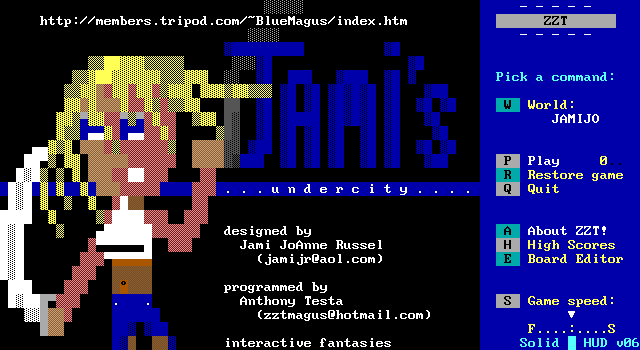
Life In The Undercity
If you're familiar with any of BlueMagus's many releases, Jami's Undercity seems like a perfect fit. BlueMagus liked his serious stories, gloomy settings, and ambiguous morals. How much of Jami's Undercity comes from Jami's ideas and how much is BlueMagus's makes it hard to say whether this is a shared style or BlueMagus's sense of aesthetics boldly showing themselves off on top of whatever game Jami imagined. Regardless of how the efforts were split in creating the world, the end result is a game that feels very thematically cohesive.
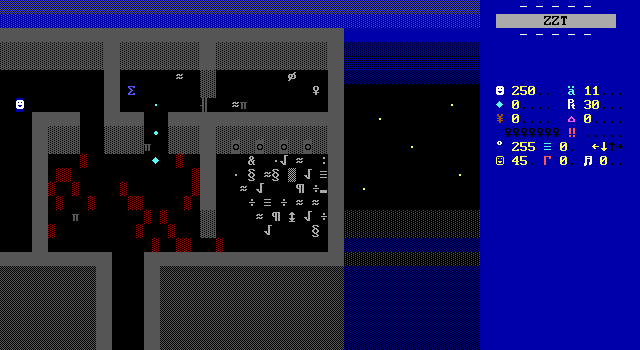
Jami's Undercity is set in a world of the occult. It's a world of vampires, demons, werewolves, and those mean religious orders that want to destroy them. It's something along the lines of the recently covered Bloodlines, but set in modern times (and codified as 1998 in a later revision). While I do love the many sword and sorcery focused ZZT fantasy games out there, I can't help but be drawn in to any world that uses a modern setting like this. BlueMagus's ability to take the real world and apply fantasy tropes to it begins here, with the game predating the New York City subway setting of Deep December by roughly a year for the original release. It's a setting that manages to include vampires, witches, and the like while also having computer consoles, firearms, and high-rises.

In ZZT, worlds set in present day are frequently power-fantasies with teenage protagonists to match the audience (at least around the year 2000 or so). Whether that teenagers power is in having a rifle in their dresser or from always being able to talk their way out of consequences, everything revolves around them above all else. Jami's Undercity may very well be a power-fantasy for Jami herself, I mean, same name and all, but nothing official.
There's a whole lot of forces at play in the background, but for Jami the events of game are personal. What starts out as a relaxing evening quickly goes south when a dying vampire knocks on her apartment door to warn Jami that Devon, her vampire (obvs.) boyfriend has been taken. Hunters of all things evil are out in full force and the streets of the city are now a war-zone. The plan is to keep Devon hostage until the break of dawn when the sun will destroy him. Jami is determined to rescue her beloved, and when the carnage nears her own apartment, she quietly slips out the rear window and down the fire escape making her way towards the Undercity.
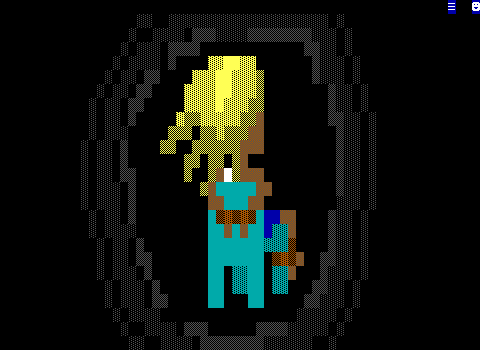
It doesn't go well.
Despite being a very capable heroine for the rest of the game, Jami's initial foray into the war gets off to a rough start. Before even reaching the ground, she manages to fall off the fire escape ladder and land in a dumpster which is quickly surrounded by demons with little interest in determining Jami's alliances. She falls unconscious but is rescued by Mahgon, a member of the demon hunters she's fighting against, who believes her to be a mere damsel in distress. Acting under orders he ties Jami up until it can be safely ascertained whether or not she's a demon in disguise. While he's easily fooled by Jami's innocent demeanor, Malachai, the headpreist doesn't buy it one bit. He immediately recognizes her as a sinner and servant of dark forces. To make matters worse, he plays to to be the one to see to her "rehabilitation".
Escape comes next. This is easily done thanks to Jami's sabre being left so close to the chair that she's been bound, allowing her to cut away at her restraints. She's then on her own in the undercity, the "underground of the underground" as one of the few friendly characters seen describes it. Using her weapons and cunning Jami must traverse several buildings filled with demonic creatures, hunter acolytes, and some particularly nasty tricks and traps if she's ever going to reunite with Devon again.

For this, BlueMagus leans in on props and background scenery to create macabre environments. Bloodstains are everywhere Jami looks, and torture devices seem like reasonable explanations for them. Feral demons stalk the halls, having to be fought off in order to travel safely. The buildings are dilapidated, using rubble to restrict travel entirely in some instances or in others being small enough piles for Jami to take the time to clear away.
It plays somewhat like a BlueMagus dungeon crawler. Unlike most of his other works, the game is set entirely in bright rooms which are more akin to traditional action world. Odds are the structure of these buildings is inspired by BlueMagus's own Refridgerator Raider albeit with much larger rooms that make use of the space available rather than the tight corridors of that title. Here Jami has to hunt down supplies, keys, and enemies in order to get past obstacles both magical and mundane.
The game's story doesn't really develop as things progress. Jami does run into some NPCs here and there with bits of information or items, none of whom really build up this war that's apparently being fought. "Find Devon." sums it up until the final chapter of the game when Jami has a run in with the headpriest Malachai again. Mahgon rushes in to save you, still not believing you to be with the vampires, going so far as to throw Malachai off the side of the building, only to very quickly learn that Jami is his enemy and that he just killed his master for nothing. Admittedly, while this is certainly what happens, the writing doesn't capture the drama that a scene like this should have. Jami goes on to open Devon's cell and the two reunite with her own blood being used to restore him. Again, in another scene that sounds cooler in your head than the actual moment in game.
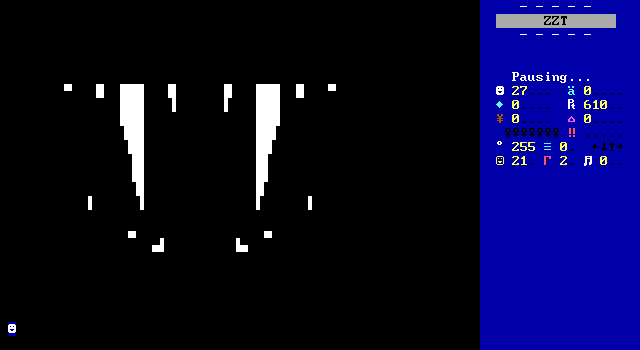
The fangs at the game's end are a great touch, and enough goes unspoken that the ending can be taken to be somewhat ambiguous, which I am quite impressed by. Everything from the game's text would lead you to believe that Devon's words of love are true and that Jami will be turned into a vampire and be Devon's forever. On the verge of death, combined with the closing shot of fangs ready to bite, and with only Jami's word to take for their relationship, I couldn't help but wonder if Jami was about to be killed to revitalize Devon.
Well, probably not, since a sequel was eventually announced. A few ads can be seen within the ZZT magazine iFantasy 4 which show the unreleased sequel's title screen and cast of characters where Jami is alive and well. (Also lmao at "Blue" the "Magus".)
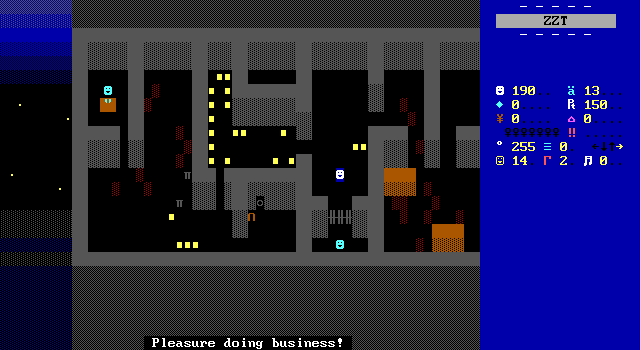
It all adds up to create a rather enjoyable experience. Jami's Undercity may not be deepest game around, but it feels very well constructed to bring the player into a unique setting and let them loose in the space. I'm rather surprised to see that neither version of the game has any z2-era reviews, making any reviews of the game that may remain be buried in ZZT magazines or rotting on archived websites. This is an excellent example of what a modern ZZT game felt like in the late 90s, and one that continues to be fun to run through today.
At a time when ZZT games began casting aside built-ins (considering them a sign of an inexperienced developer) they began putting an emphasis on creating a unified brand filled with characters and locations players would likely see again in other projects by the author. Jami is an excellent introduction to this kind of ZZT game, creating a new world that I would really enjoy getting to see more of.
Combat - Jami's Got A Gun (And A Sabre)
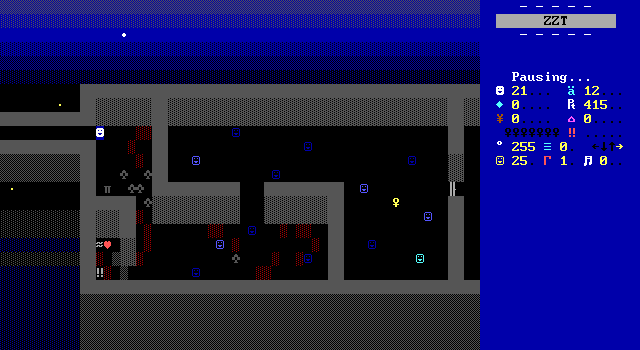
Jami's Undercity includes two modes of combat: a melee/ranged system used when fighting enemies that are mere nuisances, and an RPG engine for more elaborate fights. Those familiar with the works of BlueMagus will be well aware of the numerous well-received dungeon crawlers he released over the course of his ZZTing career. While Jami does draw from that, the game is far lighter than his usual affair. Jami isn't a game I'd describe as a dungeon-crawl really, and plays more like a traditional ZZT action game. The creatures Jami fights are of little importance and offer little challenge here rather than being a key focus of the game.
Which isn't to say that the combat is bad. It's just pretty basic stuff. Jami can use her sword by touching enemies to hurt them, or use one one of the fairly limited bullets for her gun to defeat foes in a single shot. Even if both of Jami's weapons are worth using at different times, players will likely want to conserve ammunition as the nature of the RPG engine allows for bullets to be extremely powerful, making it worth holding on to them when possible. Sometimes this may not be possible, typically after one of these RPG battles where exiting the RPG board will kick Jami to a new screen, often right in the thick of a group of enemies. Here using your gun to get out an unexpected jam is definitely the way to go as once enemies begin to surround her, health can drain quickly, and this too is a shared resource used in the RPG battles.
The enemies are implied to be bestial demonic creatures, though unlike BlueMagus's other titles, there isn't any descriptive text when Jami is harmed or the enemy is injured. They really do feel like background noise more than a serious challenge. At least, as long as you focus on one at a time instead of just rushing in to deal with them all at once. The enemies check if they're able to attack Jami frequently, but not necessarily on every cycle which makes it fairly easy for players to sneak past without suffering for it.
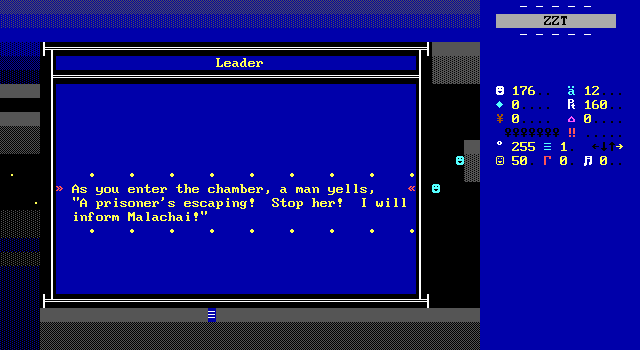
Human adversaries are only used in a single instance, but it ends up being perhaps the most well-executed encounter in the entire game. Jami is ambushed by a number of acolytes that quickly draw guns on her and don't hesitate to fire. This happens in a small room and the abrupt shift to enemies with guns is a great way to make the player panic and really screw things up for themselves.
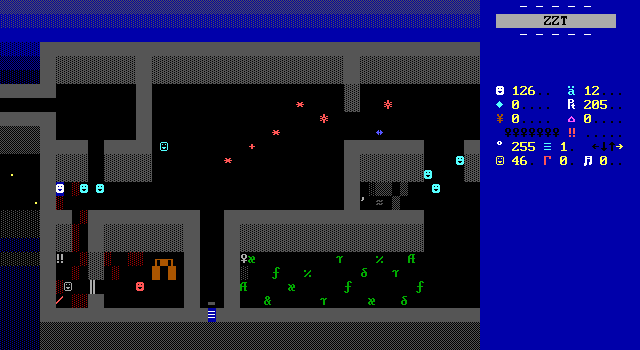
Where it excels though, is that it's actually a scripted encounter. After lord knows how many ZZT worlds which let players take advantage of friendly fire to clear out groups of enemies without firing a single shot, BlueMagus actually designs his way around this. Yes these objects suddenly get quite violent, but the chaos unexpectedly stops quickly. Enemies fire in pre-coded directions at specific times. Given the small area, it feels entirely organic. It's only when you step outside where more acolytes are waiting that you realize that while these objects are capable of shooting, they don't just do so when aligned with the player. ...Save for one who is almost a guaranteed source of a friendly fire incident before they sheepishly withdraw their weapon. Since the player has had so little time to observe and learn from these enemies' behavior, it's very easy find yourself waiting patiently for a group to line up, expecting them to take each other out, only to realize that they actually have stopped shooting and are now getting dangerously close to Jami.
It's over so fast that you could totally miss it if you aren't looking. I had no idea the encounter was actually pre-determined in my playthrough, only realizing the truth when going back to the code for this article to figure out why they stopped shooting. It's easy to trick yourself into thinking it's just bad luck with objects that are in close proximity blocking bullets from being fired just before they move out of the way and create a gap for a bullet to spawn.
I'm unaware of any other ZZT game that stops enemies from shooting to prevent the friendly fire syndrome that plagues most action titles. It works because it's a one-time thing, but that moment of chaos makes it a remarkably effective moment. If it didn't blend in so seamlessly, I'd call it the most impressive moment in the entire game. Perhaps it still is the most impressive because it blends in so well.
I do wish the other enemies could be anywhere near as notable. Careful players can take them out with little to no damage in most instances. They lack any defining characteristics. They have names, but players will only see them if they're killed. Looking at their code to see their names reveals that Jami is fighting "Things" throughout the game. A second non-human enemy shows up on a single board that is referred to internally as a "Fugger", a great name that should be prominent.
The fuggers look like ruffians and move around the player in a way that does make them more of a threat, but in practice they only appear in a single tiny room on one board so you can't take time to appreciate any differences. If the RPG engine didn't make bullets something to save, BlueMagus could have just as well used tigers and ruffians rather than objects with those characters. He'd probably have been dinged in review scores, if there were any.
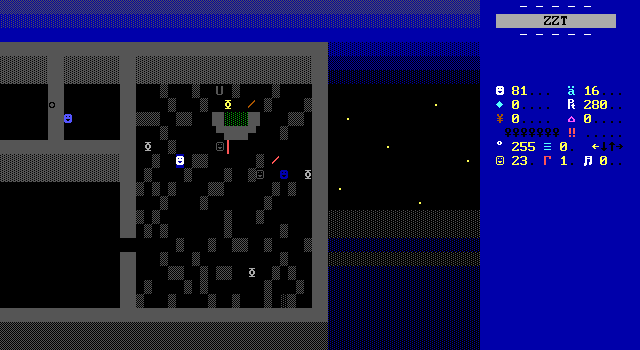
Aside from the final boss fight in traditional combat, there is one other special encounter that does stand out. One room contains a witch stirring a massive cauldron. Upon being interrupted, she begins to attack Jami with stars and animates some nearby statues.
This is the toughest encounter by far, which I want to stress is a well designed fight even if stars are involved. Those stars don't have any timer objects to destroy them early, which typically means things get out of hand quickly. Instead BlueMagus balances the fight by just making the witch move rather slowly and with a lengthy pause before throwing a star. The room is also filled with debris in the form of breakable walls so players can fairly easily maneuver Jami in such a way that the star strikes a breakable instead. As one last bit of challenge, the witch can phase herself out of harm's way when it comes to bullets, requiring the use of Jami's sabre to defeat her.
The fight's solid to be sure, though I wish there was any depth to the character. The witch just attacks and Jami just fights with the only some Wizard of Oz "I'll get you, my pretty!" for dialog. The fight lacks any connection to Devon, the demons, or the religious order that might give it more purpose than the monsters lurking on most boards. It seems like it could've been a good place to add in a little development to the story in some way. Perhaps the witch could have attacked suspecting Jami to be with the other acolytes. Maybe she could have just been a jerk! Instead she's just kind of another obstacle.
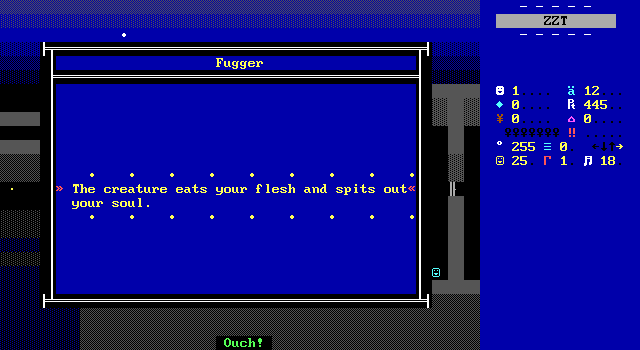
The lack of oomph to combat isn't a deal-breaker. Jami's Undercity isn't a dungeon crawler that revolves around this specific style of fighting. The enemies get the job done even if they don't impress save for the one time guns enter the equation. In most cases this would just be a mediocre aspect of a larger world. It's only because BlueMagus is on the author list that it becomes a bit of a letdown. BlueMagus has shown himself to be capable of more engaging combat, as well as creating enemies that have some personality. It's something I'd expect from him, which makes its absence something readily noticed.
Jamijo Battle Engine
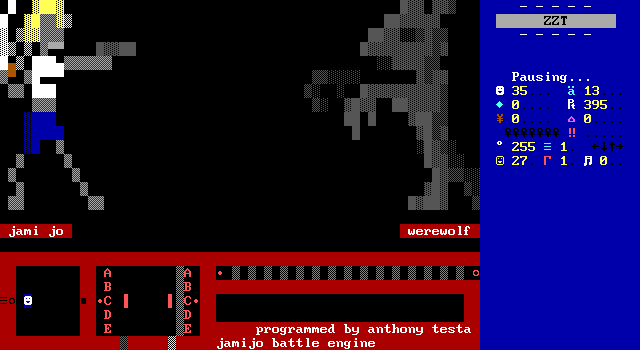
There's more to the combat in Jami's Undercity than the wishy-washy action. As with countless other ZZT worlds in the back half of the 90s, the game also features its own RPG battle engine to create more spectacular fight scenes rather than objects that just need to be stabbed/shot a whole bunch. The engine that's been implemented here was one that really struck me as unique even when I was a child playing the remixed edition of the game. Even now, I still found it impressive, and definitely something that I would have loved to see developed further. In its current state, there's a lot of potential, but the unique aspects are mostly outside of the player's control, which turns into another engine that boils down to picking an attack from a menu, and hoping the dice roll in your favor until your enemy is defeated.
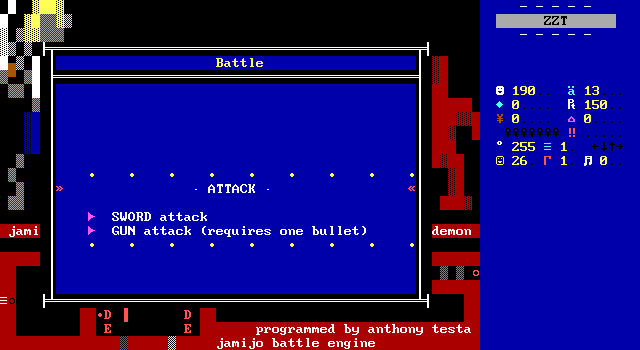
That's kind of the ZZT RPG experience in a nutshell, and it's further dragged down by the lack of any animations. Instead large depictions of the characters are portrayed on opposite ends of the board, which is a style that has worked elsewhere such as in Nivek's Defender of Castle Sin. Unlike Nivek's engine which keeps the player engaged in the static-looking combat by offering a significant number of spells to cast, BlueMagus's engine only has two attacks available for the duration of the game.
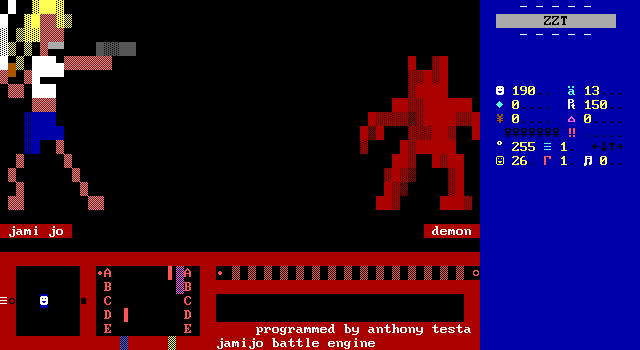
Let's start tearing this down to see why it feels so different yet plays so similar to other ZZT RPGs.
Some of it follows the norm. The enemy's health is represented by a row of breakables that are shot as Jami deals damage. For the player's health, the less conventional but not uncommon approach of using the player's actual health value is used. Conveniently for comparison, this applies to Castle Sin as well.
In an ideally designed game, the benefit of such a choice is that players won't be able to just focus purely on attacking as when the battle is over, it could turn out to be a pyrrhic victory. This leads to the downside that you can just put yourself in an unwinnable state if you enter these fights with too little health. Castle Sin gets around this by having a healing spell to set your health back up to 200. Jami has nothing of the sort so her health perpetually dwindles as the game goes on, with only a very limited number of healing items scattered throughout the undercity. There is a shop on one board, but gems are so hard to come by that you really can't rely on it, nor can you access it for very long.
While you might get away with such a design if Jami started with a large amount of health, I did wind up having to cheat towards the end of the game because of this system. Some good rolls in the RPG battles or some expert play when dealing with enemies on more traditional gameplay boards certainly put success in the realm of possibility at least. I don't recall needing to cheat in previous playthroughs at least.
Jami's offense in RPG mode is identical to outside of it. She can still slash with her sabre, and fire handgun provided she has ammunition. The engine makes these two weapons behave significantly different in RPG mode.
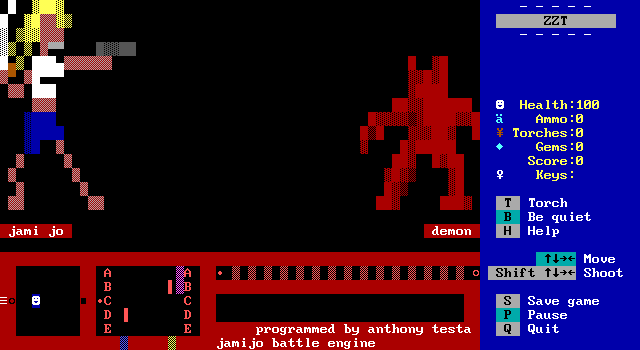
The engine sets up the two opponents with "Stations" from A-E. These stations are what perform attacks. Jami's sabre attack will cause all of her Stations to shoot a bullet eastward at the enemy. Some enemy stations begin with shields in the form of a breakable wall which allows them to absorb an initial hit to that station. When a station is successfully shot, either Jami's health will decrease of a bullet will be fired to decrease the enemy health bar. To add a little chaos to the outcome, a "Blocker" will randomly move up and down, protecting the Station behind it and reducing Jami's damage output. When either character attacks, their blocker will get out of the way. This prevents accidental self-sabotage of attacks.
Jami's second attack is to shoot her gun. The red circle behind Jami's Stations is used to mark which station will be used when this attack is selected. The gun causes a series of bullets to be fired from a single Station at the enemy Stations.
The enemy will in turn have their own attacks which tend to be pretty similar to Jami's. That's the basics, but the specific mechanism used has some considerable impact on how the battles play out compared to typical ZZT RPGs.
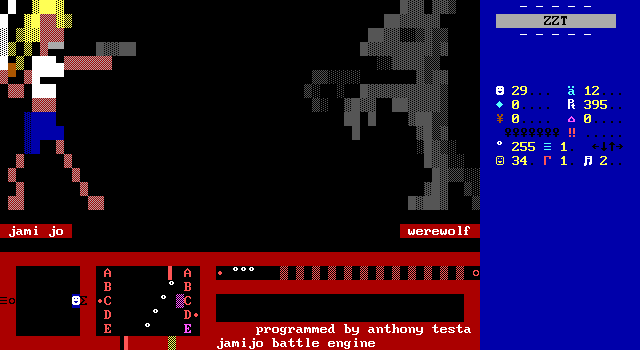
For one thing, the sword attack is staggered so that rather than producing a vertical line of bullets, it produces a slash shape. Since the Blockers move randomly, this means some bad luck could get them to be in just the right position to block a significant portion of the attack's damage. As for her gun, the player can try wait until the enemy Blocker is hanging out around A and her active Station for the attack is nearing E. Things move too quickly and respond too slowly to truly game the system, which offers a significantly wider damage spread than you'd expect to see. It leads to very satisfying moments when your Blocker absorbs an entire attack, or when your shots go through perfectly.
The shields provide a small edge for the enemies that have significantly less health than Jami for most of the game. Since there's not too much control of how the objects move, it creates a tactical decision of whether you want to start with your sword attack to hopefully clear out the shields, or just try to aim your gun at targets that will take the full force of your attack.
That's the basics, and covers everything that appears in the first of the game's fights. As the player encounters stronger foes, and has opportunities to power themselves up somewhat things get slightly more involved. A sword upgrade can be purchased early on or found later that upgrades your sword attacks to fire a second bullet from a random Station using the same selection method used by the gun. Later enemies have more complexities with their Stations in an attempt to make things more strategic. Some enemies will have a rotating weak-point, where one random Station will take double damage on each turn. This tempts the player to try and aim their gun at the proper station for massive damage. Others will do the opposite and have a station that's immune to damage entirely (although the Blocker will still attempt to cover it). Here sword attacks are made weaker, and the gun can effectively miss entirely, leading to a wasted turn.
It all works really well. While Jami's Undercity lacks in animation and text to make these scenes more memorable, it excels in actually holding the player's interest. Weaknesses and immunities for stations begin to be introduced starting with the second fight, and once they're in place I found myself patiently waiting in hopes of performing a devastating attack. Dress this up with the usual invisible walls for animation or include some smaller depictions of the characters that could move around, and this could have genuinely been one of the best RPG engines of the 90s. What it lacks unfortunately means players instead only hyper-fixate on a tiny piece of the board, not thinking about how Jami is going to fare in a fight against a werewolf, but rather how long until the Blocker moves away from where you're hoping to shoot.
Jami's Undercity is a short game with fewer than twenty playable boards, so to fit four RPG battles in makes it a pretty core component of the game that's well executed. The battles do not get boring or feel repetitive even with limited actions available. Yet I can't help but think BlueMagus was really on to something here. The biggest criticism is the over reliance on randomness. It works, and the fact that it's quite rare to do zero damage since attacks aren't all-or-nothing keeps things from getting frustrating compared to something like Warlord's Temple where a few misses in a row will render battles unwinnable.
I feel like there's a lot of potential with this kind of implementation of attacks and defenses. If there was more control there would be plenty of opportunities to add strategic complexity to these fights. Give Jami the ability to coerce her Blocker in some way to try and defend high or low, and give enemies dedicated attacks that come from specific stations every time and then the player could play an active role in reducing incoming damage instead of leaving it up to chance. The shields of breakable walls that stations have could be a perk Jami obtains as well, and could be enhanced further for friend and foe by regenerating over time or having objects instantly replace them a set number of times so that you can have more durable shields without having to widen the targeting area.
The sword would actually lend itself quite well to this. A slash could fire from each station. A stab could be focused on just one. I could spitball ideas all day, plenty of which I think wouldn't take too much for a ZZT game from the 90s to pull off.
Potential aside, what's here is still great for a game of this length. If this was some multi-file story BlueMagus would definitely need to give players more than what these four battles do to shake things up, and I don't doubt that he would have. For a brief adventure into a world of vampires, werewolves, and dark rituals, Jami's Undercity won't let you down. It will leave you impressed and wanting more from this engine, a rarity for ZZT-OOP now more than twenty years old at this point.


